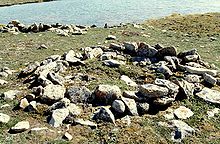- Thule people
-
The Thule (
 /ˈtuːliː/ or /ˈθjuːl/)[1] or proto-Inuit were the ancestors of all modern Inuit. They developed in coastal Alaska by AD 1000 and expanded eastwards across Canada, reaching Greenland by the 13th century.[2] In the process, they replaced people of the earlier Dorset culture that had previously inhabited the region. The appellation "Thule" originates from the location of Thule (in 1953 relocated to Qaanaaq) in northwest Greenland, facing Canada, where the archaeological remains of the people were first found at Comer's Midden. The links between the Thule and the Inuit are biological, cultural, and linguistic.
/ˈtuːliː/ or /ˈθjuːl/)[1] or proto-Inuit were the ancestors of all modern Inuit. They developed in coastal Alaska by AD 1000 and expanded eastwards across Canada, reaching Greenland by the 13th century.[2] In the process, they replaced people of the earlier Dorset culture that had previously inhabited the region. The appellation "Thule" originates from the location of Thule (in 1953 relocated to Qaanaaq) in northwest Greenland, facing Canada, where the archaeological remains of the people were first found at Comer's Midden. The links between the Thule and the Inuit are biological, cultural, and linguistic.History
Evidence supports the idea that the Thule (and also the Dorset, but to a lesser degree) were in contact with the Vikings, who had reached the shores of Canada in the 11th century. In Viking sources, these peoples are called the Skræling. Some Thule migrated southward, in the "Second Expansion" or "Second Phase". By the 13th or 14th century, the Thule had occupied an area currently inhabited by the Central Inuit, and by the 15th century, the Thule replaced the Dorset culture. Intensified contacts with Europeans began in the 18th century. Compounded by the already disruptive effects of the "Little Ice Age" (1650–1850), the Thule communities broke apart, and the people were henceforward known as the Eskimo and, later, Inuit.
Culture
Known for using slate knives, umiaks, seal-skin floats and toggling harpoons, the Thule subsisted primarily on marine animals—especially large sea mammals.
Thule winter settlements usually had one to four houses with about ten people each. Their houses were made of whale bones from summer hunts. Other structures included kill sites, food caches, and tent encampments. Some major settlements may have had more than a dozen houses, although not all were inhabited at the same time by the approximately fifty residents.
References
Categories:- Inuit history
- Archaeological cultures of North America
- Greenlandic people
- Native American history of Alaska
- Prehistory of the Arctic
Wikimedia Foundation. 2010.



